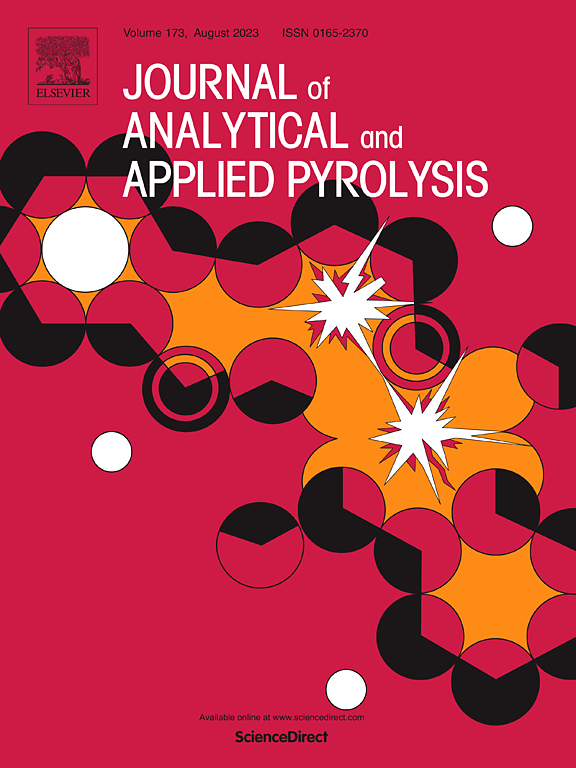Aldehydes and diols-induced in-situ modification of lignin for high β-O-4 retention and controllable pyrolysis pathways of lignin
IF 5.8
2区 化学
Q1 CHEMISTRY, ANALYTICAL
引用次数: 0
Abstract
Lignin condensation during pretreatment leads to its high thermal stability, limiting its utilization through pyrolysis. Hence, lignin extraction and modification were realized simultaneously, using different aldehydes and diols as modifiers during organic solvent pretreatment of bamboo leaves. Then, the change in lignin’s fast pyrolysis behavior and the mechanism induced by the modification were explored. The modifiers improved the lignin removal ratio (from 77.03 % to a maximum of 84.67 %), and modified the lignin by forming Cα-alkoxy structures (for diols) and acetals (for aldehydes). This facilitated the decrease of lignin molecular weight to 4760–8590 Da and the significant increase of β-O-4 content to 51.90–68.51 %. As a result, the modification led to lower average activation energy (91.1–110.9 kJ/mol), improved bio-oil yield (maximum of 63.42 wt%), and markedly increased yield of 2-methoxy-4-vinylphenol (to 214 %) and 2,3-dihydrobenzofuran (to 159 %) during lignin pyrolysis. Interestingly, aldehydes-induced modification efficiently changed the pyrolysis pathway, leading to the selective preparation of a specific product (3-hydroxy-4-methoxybenzaldehyde). The results provide a feasible way to control the lignin pyrolysis process and product distribution by modifying the lignin structure during pretreatment.
醛和二醇诱导木质素原位改性以获得高β-O-4保留率和可控的木质素热解途径
预处理过程中木质素的缩聚导致其热稳定性高,限制了其热解利用。因此,在竹叶有机溶剂预处理过程中,采用不同醛类和二醇类作为改性剂,实现了木质素的提取和改性同时进行。然后,探讨了改性对木质素快速热解行为的影响及其机理。改性剂提高了木质素的去除率(从77.03 %提高到最高84.67 %),并通过形成c α-烷氧基结构(对于二醇)和缩醛(对于醛)对木质素进行改性。这使得木质素分子量降低到4760 ~ 8590 Da, β-O-4含量显著增加到51.90 ~ 68.51 %。结果表明,改性木质素的平均活化能降低(91.1 ~ 110.9 kJ/mol),生物油收率提高(最高可达63.42 wt%), 2-甲氧基-4-乙烯基苯酚和2,3-二氢苯并呋喃的收率显著提高(分别为214 %和159 %)。有趣的是,醛类诱导的改性有效地改变了热解途径,导致特定产物(3-羟基-4-甲氧基苯甲醛)的选择性制备。研究结果为在预处理过程中通过改变木质素结构来控制木质素热解过程和产物分布提供了一条可行的途径。
本文章由计算机程序翻译,如有差异,请以英文原文为准。
求助全文
约1分钟内获得全文
求助全文
来源期刊
CiteScore
9.10
自引率
11.70%
发文量
340
审稿时长
44 days
期刊介绍:
The Journal of Analytical and Applied Pyrolysis (JAAP) is devoted to the publication of papers dealing with innovative applications of pyrolysis processes, the characterization of products related to pyrolysis reactions, and investigations of reaction mechanism. To be considered by JAAP, a manuscript should present significant progress in these topics. The novelty must be satisfactorily argued in the cover letter. A manuscript with a cover letter to the editor not addressing the novelty is likely to be rejected without review.

 求助内容:
求助内容: 应助结果提醒方式:
应助结果提醒方式:


